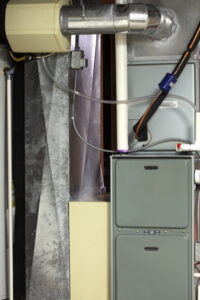
It’s important for us in the heating and air conditioning business to reassure customers that their furnaces are not super dangerous. Gas furnaces would never be permitted in homes—let alone millions of homes across the country—if their operation commonly posed a threat to people.
But it’s important for us to let customers know there are ways a furnace, especially an older one or one that hasn’t gotten regular maintenance, can pose hazards. Keeping up with maintenance can lower the chance of problems like this occurring down to almost nothing, but a bit of knowledge also goes a long way. To understand when it’s time for a new furnace, explore the 50% rule for repair vs. replacement.
In that spirit, we’re going to look at a major furnace problem that can put your household in jeopardy: a cracked heat exchanger.
The Heat Exchanger Basics
What’s a heat exchanger? It’s the part of a gas furnace that actually heats: a metal container that holds the hot combustion gas from the burners and transfers the heat from its surface to the air moving through the furnace and into the ventilation system. This lets the gases heat up the air without ever coming into contact with it. Once the heating cycle is finished, the remaining exhaust gases in the exchanger go out a flue to the outside.
A Cracked Exchanger
Over time, the metal of the heat exchanger undergoes extensive stress from expanding and contracting during heating cycles. This may eventually lead to cracks. Another possible source for cracks in the exchanger is corrosion. The vapor in exhaust gases reacts with the metal, and after many years it may create corrosion that weakens the metal, making cracks more likely. This process will speed up if the furnace has been venting poorly.
Although the cracks in a heat exchanger are tiny and normally wouldn’t let anything escape through them, they can stretch open as the metal of the exchanger heats up. Allowing any amount of carbon monoxide from the exchanger into the air can create serious health hazards for the home. If you’re unsure about the severity of a damaged exchanger, see why a damaged heat exchanger is such a big deal and why it should be addressed immediately.
Prevention and Detection
If you aren’t an HVAC professional, it’s difficult to tell if a furnace has a cracked heat exchanger. You may hear a clicking sound after the blower fan turns off, although this also indicates other possible problems. Call for experts to check into it, and we also recommend shutting off the gas to the furnace if you have any suspicions.
The best way to protect your household from this furnace fault is to schedule regular maintenance for your furnace each fall. Technicians always closely inspect the furnace’s heat exchanger to see if there are cracks or signs of corrosion. If you have an older furnace (15 years or older), be especially careful about having routine inspections for the system. We recommend getting a replacement furnace for one this old, which is not only good for safety but also good for energy efficiency and your future budget. If you notice warning signs, review the signs your furnace is failing to determine whether it’s time for a replacement.
If you have any questions about your home heating in Hudson, OH, or any repair concerns, never hesitate to call us.
Crown Group Ohio serves Stark & Summit Counties. Call us 24 hours a day, 7 days a week when you need heating repair.


